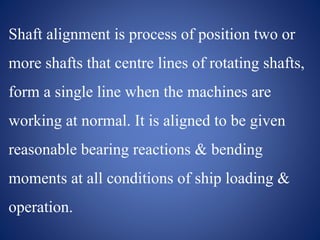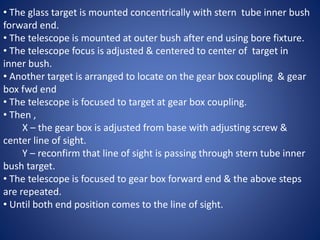Shaft alignment
- 2. Shaft alignment is process of position two or more shafts that centre lines of rotating shafts, form a single line when the machines are working at normal. It is aligned to be given reasonable bearing reactions & bending moments at all conditions of ship loading & operation.
- 4. •Destruction or abnormal wear of the stern bearings of the shafting or of reduction gear bearings or of main engine bearings. •Destruction of the bronze sleeve of the propeller shaft. •Cracking or rupture of the propeller shaft or of the crankshaft. •Natural vibrations of the shafting or of its supports.
- 6. • Pilgrim wire • Line of sight (telescopic) • Gap & offset
- 8. If the misaligned shafts center lines are parallel but not coincident, the misalignment is called axial misalignment
- 9. If the misaligned shafts meet at a point but are not parallel, then the misalignment is called angular or radial misalignment.
- 11. A wire is used as a reference line. The wire is tensioned to standard amount by fixing at one end and having a weight over a pulley at the other end. Then distance from wire to bearings are measured, allowance being made for sagging of the wire.
- 13. The piano wire is centered to the after end of stern tube outer bush by using inside micrometer or caliper. For that we should calculate the sag at that point. There is a method to calculate the sag
- 14. G y x L L - length of wire (fixed end to end) (m) G - hanging weight (kg) = 30kg P - wire weight per meter length (kg/m) =0.002kg/m y - sag at given length (m) x - distance (m) Wire sag calculation Y =P x X(L – X)/2G
- 15. The bushes can be machined on either the internal diameter or the external diameter depends on the material of construction and availability of machining margin. The bushes shown below include one where the center line of the shafting and the bush match, while the other one shows the bearing material machined eccentrically to achieve concentricity between shaft line and the bush center.
- 17. The telescopic alignment commonly used for intermediate shaft alignment & crank shaft alignment .because it is accurate more than piano wire alignment & easy to do. Any type of alignments are wanted two fixed center . In this alignment I get outer bush aft end & inner bush forward end as the fixed point. It is depend upon our requirement & placed.
- 18. • The glass target is mounted concentrically with stern tube inner bush forward end. • The telescope is mounted at outer bush after end using bore fixture. • The telescope focus is adjusted & centered to center of target in inner bush. • Another target is arranged to locate on the gear box coupling & gear box fwd end • The telescope is focused to target at gear box coupling. • Then , X – the gear box is adjusted from base with adjusting screw & center line of sight. Y – reconfirm that line of sight is passing through stern tube inner bush target. • The telescope is focused to gear box forward end & the above steps are repeated. • Until both end position comes to the line of sight.



















